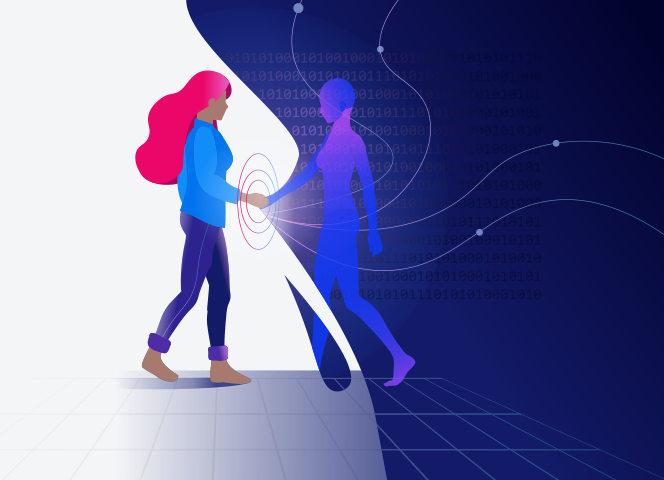Artificial intelligence (AI) within recruitment is becoming increasingly common – both as a topic of discussion and as an obtainable solution for hiring teams looking to transform their processes.
But is AI really a smarter recruiting practice? We explore the ways AI is currently being used in recruitment workflows and its perceived benefits, along with the drawbacks and potential legal issues of using currently available AI recruitment technology.
What is AI recruiting?
AI hiring refers to the recent adoption of using artificial intelligence (AI) to automate parts of the hiring process, from sourcing and screening to interviewing and evaluating candidates.
It’s important to note upfront that not all recruitment tech solutions are examples of AI. For a technology to be considered AI-powered, it needs to feature components of machine learning (the system learns and improves by gathering data, rather than being explicitly programmed).
Here’s an example of an AI recruiting process vs automation that’s used within recruiting tech:

How is AI being used in recruiting?
Here is how some companies are using AI within their recruitment practices:
· Write ‘enticing’ job posts
Using data findings, AI can suggest the most effective words and phrases to include in a job posting based on the job title, industry, and location.
· Automatic job matching
In some cases, AI is hard at work before a candidate has even applied. AI has the ability to determine the requirements of a job role based on previous or similar applicants for the role. This data is used to dictate which candidates see a job posting based on their experience, knowledge, and skills.
· Communicating with candidates via chatbot
AI can be used to mimic human conversational abilities, using technology such as natural language understanding (NLU) to comprehend a candidate’s text-based messages and know how to respond. These chatbots can be used to schedule or determine job fit. They can even recommend other jobs that might be a fit, and encourage applicants to apply.
· Filtering candidates
AI can scan or evaluate candidates’ resumes using an algorithm to scan for keywords that are relevant to a job role or preferred skill set. Some AI software can also analyze candidate data to discover their online presence for a broader scope of their history and abilities.
· Video interview candidates
AI software can analyze video interview transcripts using natural language processing (NLP), without recruiters needing to be present. Candidates complete a one-way AI-based video interview by recording their answers to preset questions. AI performs an algorithmic analysis on the recording and determines the candidate’s outcome.
Here are some features that are analyzed in an AI-based video interview:
- Word and phrase choices
- Tone of voice
- Body language
- Facial expressions
- Emotional responses
- Eye movement
- Communication skills
- Level of interest
- Level of confidence
Non-AI platforms offer a convenient solution that allows candidates to interview at a time that works best for them, and recruiters to evaluate the videos when they’re available to do so.
Leading video interview providers use a structured interview methodology, which includes a structured rating guide and standard rating scale. This helps to facilitate a fair and comparable interview process that allows recruiters to evaluate efficiently, every time.
How does an AI interview work?
Within the recruiting process, AI “robots” can speak to and understand candidates through the use of conversational AI. Conversational AI is used to facilitate human-like chatbot conversations with candidates, and aspects of it are also used in AI-evaluated audio and video interviews.
How does conversational AI work? The AI-powered application receives the spoken word (or written text) and transcribes it into a machine-readable text. Next, the application uses natural language understanding (NLU), which is the first component of natural language processing (NLP), to understand the intent of the text. Generally, in interviews, the system isn’t required to make a response, so NLP is used to evaluate the text, based on AI algorithms.
In circumstances where a response is required (e.g. chatbot interactions), the system’s dialogue management (DM) formulates a response and converts it into an understandable format using natural language generation (NLG), the other component of NLP. The application delivers the response to the user via text, or text-to-speech, depending on the conversation style.
Lastly, the application uses machine learning (ML) to improve the responses for future interactions by accepting corrections and carrying context from one conversation to the next.

In theory, conversational AI is an efficient and convenient way to filter and engage with candidates. However, in real-world use cases, it has limitations. Different languages, dialects, and accents fail to be understood properly by AI applications, meaning some transcriptions are full of incorrect information, which can ultimately cause bias. Even in text-based conversations, instances of sarcasm, emojis, and slang can confuse AI, causing misinterpretations.

Why are companies using AI in recruiting?
Companies seek out AI to assist with their recruiting for the following reasons:

Will AI replace recruiters?

AI allows hiring teams to remove many of the repetitive, time-consuming processes from their recruitment workflows. Companies that produce AI recruiting software say this allows recruiters more time to focus on engaging with candidates, training hiring teams, and developing a better hiring process. However, many AI tools do replace the need for recruiters or hiring managers to engage with candidates. It seems a little contradictory.
Are we heading towards a dystopian future where robots are in full control of corporate hiring? The short answer is no, nor should any company want AI to take over their human taskforce. AI isn’t able to replace the social skills, empathy, and negotiating abilities needed for a successful recruitment workflow, particularly while AI recruiting is still considered to be in its infancy.
The full blog post was written by Vid Cruiter and published on their website here.






